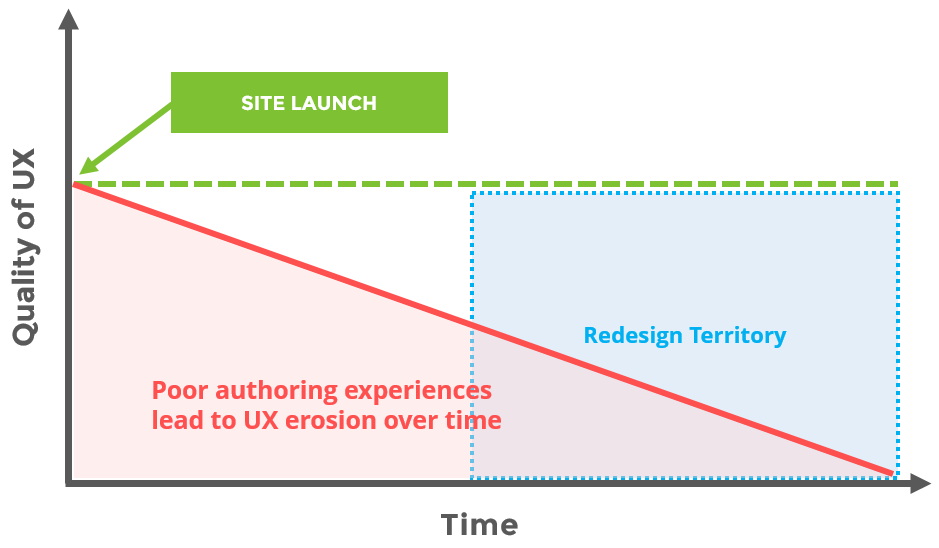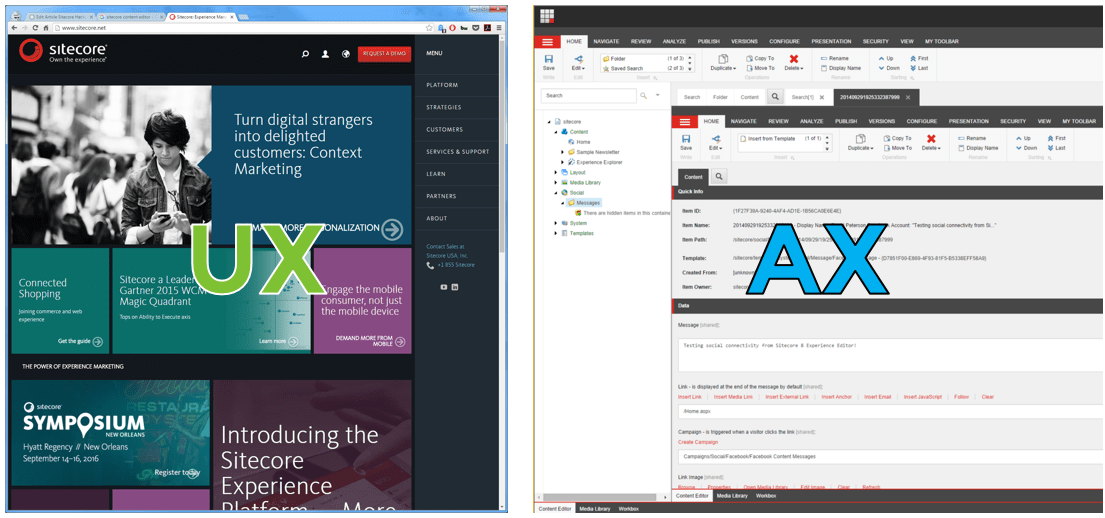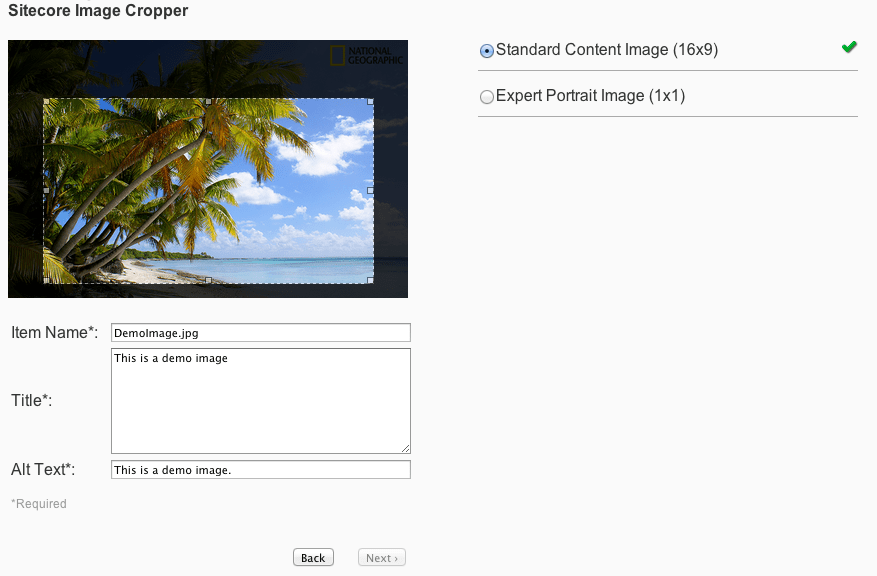A Key Component to Great User Experience (UX) - The Author Experience (AX)

Most of our clients don’t think of themselves as “digital marketers”. They’re communications teams and content producers. These unsung digital heroes spend the better part of their days wrangling Word docs, working in email, clicking through CMS menus and filling out cryptic forms. They do all this while trying to reverse engineer the resulting User Experience (UX) on the website.

It’s perplexing that companies spend the bulk of their budgets on content-related technologies and resources, yet pay little attention to the efficiency of the operational processes that enable them. Most of the focus goes into the front-end (the user experience (UX) and design).
Here’s a common scenario: All eyes are on the design and UX throughout the duration of a project (all that back-end stuff is not as sexy for executive stakeholders). You plot out a thoughtful user experience and start creating. The designs look great and everyone approves. Then the site launches. From there on it suffers from a steady stream of erosion until it gets bad enough to start the next redesign. Wash, rinse, repeat.
Authors Hold the Keys to User Experience
Great user experiences (UX) are dependent on equally great authoring experiences (AX). While “authoring” is a bit of a misnomer for the many people and activities that go into managing a website, it’s a short-hand way of referring to all those things.
The perspective of an author is mostly detached from the end user. However, everything an author does affects a user, whether they’re conscious of it or not. The challenging part of a good CMS is that it’s intentionally separated from the visual presentation of the website. While most CMS tools now offer in-page editing, that concept is mostly at odds with omni-channel content management. When authors are managing content in a WYSIWYG (“what you see is what you get”) paradigm, they’re overwhelmingly biased towards that single presentation layer – the desktop – even though that’s a dated concept (content can now be presented anytime, anywhere, on just about any device).
When authors struggle with managing the site they tend to take liberties (read: hack) to get the system to do what they want, or worse, they avoid doing something that would benefit users because it’s too cumbersome. Over time this leads to inline rich-text styling (mingling HTML with raw content) and augmented functionality being used for things it wasn’t intended to. This doesn’t happen overnight; it’s not easy to spot until it’s too late. It continues to creep up slowly until one day it rears its ugly head and spurs the need for conversations around the next redesign.
"Everything an author does affects a user, whether they’re conscious of it or not. "

It’s widely accepted by experts that companies should change their approach. The big-bang redesign is supposed to be a thing of the past. The recommended path is to “evolve and iterate” instead of “tear down and recreate”. Yet we still see companies regularly letting their sites devolve to the point of needing a full-scale redesign every few years.
“Peak UX” is on the day of launch and it’s all downhill from there. This often stems from a lack of focus on AX and the related needs of those who manage the website. With some incremental investment in AX, you just might be able to drop the term “redesign” from your vocabulary and put that money into value-generating ideas.
Applying User-Centered Design Principles to Authoring
Take everything you know about UX and apply it to AX. Start by assessing the audience – the people who are involved with creating content and managing user experience. Research who they are, how they work, and what they want. Create personas to represent them, and to ensure that design and implementation decisions consider their needs. Test the solution with real users, listen to their feedback, and make adjustments. Continue to focus on these users by observing how they work, measuring their activities, and acting on their feedback.

Authors don’t just manage the back-end; they fill out forms and toggle through menus in attempts to decode what effect it’s having on the front-end.
AX Improvements Can Produce Instant ROI
One my favorite examples of Author Experience is an elegant solution we created years ago for some of our clients who incorporate a lot of images in their content.
Here’s what that process looked like before:
An article page had a featured full-width image at the top. This same article also appeared in lists and feeds so it required two additional images: one for thumbnail views, and another for a related content listing. Authors now had 3 different image files that needed to be created from the same source file. It all seems pretty straightforward, except that each image size had a different aspect ratio that required manual editing.
Now let’s look at what all of this means for an author who’s creating an article:
- Source the original hi-res image
- Open Photoshop (or email the graphic designer)
- Calculate the proper dimensions based on the aspect ratio
- Resize the source image for the web
- Ensure the cropping didn’t cut off someone’s head or skew the image and save it locally
- Upload the file to the CMS directory
- Find the original article item in the CMS
- Locate the proper field for adding the image
- Browse to locate the image in the CMS directory and add it
- Repeat steps 1-9 two more times for thumbnail and listing feature images
- Publish the article
- Get a bunch of emails from people at your company noting that the images aren’t showing up on the live site
- Realize that you forgot to publish all the images
- Go back and publish the images
- Review the page to make sure it looks good
- Wait a few weeks before realizing that your SEO went down because you accidentally used images that were way too big in file size and it killed your page load performance
- Optimize the images, republish, and wait a few months to see if your SEO recovers
- Realize that you forgot to add Alt text and image descriptions
- Add in the metadata and republish images
- Done
When we added up all the time that goes into this process it totaled more than 10 hours per week across the authoring team (most of our clients produce a lot of content). Let’s say that the loaded costs for this operation come out to $100/hour. That’s more than $50,000 per year spent on managing images. This doesn’t even include the opportunity costs resulting from time that was taken away from creating better content or optimizing the user experience. It also doesn’t account for all the times an author accidentally adds a super hi-res image that is 5MB and uses it for a thumbnail, but it’s safe to say there’s a major cost associated with quadrupling page load times.
Now let’s look at the “after”:
Once we honed in on the level effort (and frustration) associated with the image tasks, we developed a plan for automation. Scripts were created that dynamically inherited the aspect ratios for each image field. Then we instituted a method of cropping images and optimizing the file size for web performance, without sacrificing quality. From there forward, here’s what the authoring experience looked like:
- Upload hi-res image to the CMS from within the article item
- Click “run image cropper” button
- Done
The script auto-generates perfectly sized images, optimizes the quality and file weight, neatly stores them in the CMS, tags them with metadata, and automatically associates them with the proper form fields on a content item. Authors never had to hassle with images again. In the event that they wanted some manual control, we implemented a visual cropping tool that allows them to adjust the focal point of the image, from within the CMS.

This automation project only cost a small fraction of what the annual recurring costs were for managing images. The project paid for itself in under 3 months and will continue to generate returns forever. It also resulted in happier authors, since they were able to spend more of their time on higher value tasks, instead of menial, mundane activities. This is just one small example of the many things we can do to improve the authoring experience.
Happy Authors Create Better User Experiences
Authors who work in a CMS all day have no shortage of gripes about how the system works or behaves. After interviewing dozens of authors from all types of organizations, we’ve found that most of them thought, “That’s just how the system works” and they blame the CMS product for their pains. They’re relieved when they find out that it doesn’t have to be that way. Systems like Sitecore, Adobe, and Drupal allow for easy modifications to enhance authoring and increase productivity.
There will always be a healthy tension between AX and UX, but when you find harmony between them, good things happen. There is no shortage of opportunities for improvement that will save you money and free up resources to work on more productive tasks.
Are you an unhappy author? Let us know and we can audit your CMS implementation and internal processes to find ways to make it better. And we’ll show you how it can pay for itself with positive ROI.



